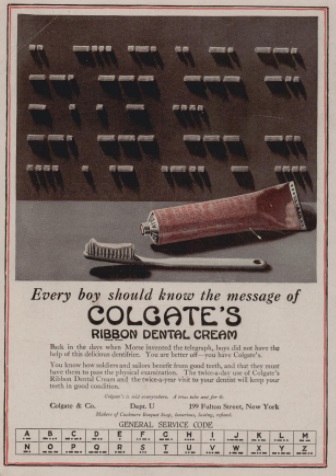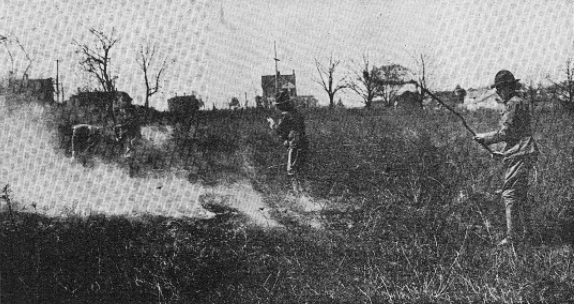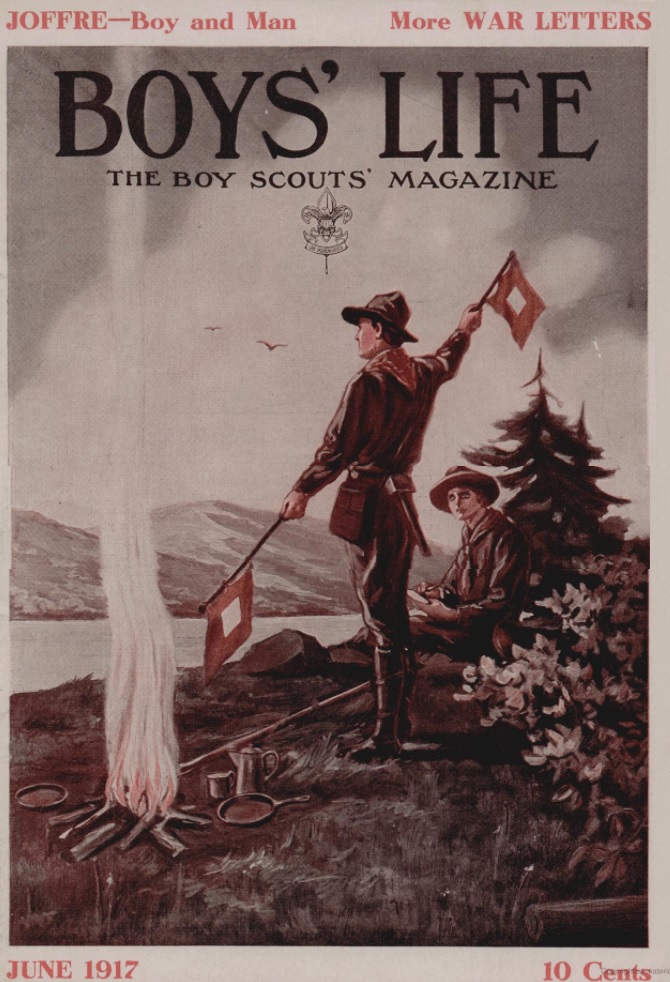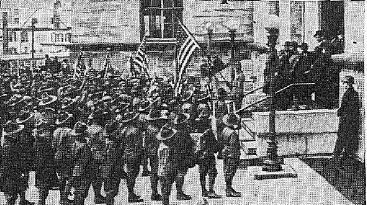A hundred years ago this month, both the front and back cover of the June 1917 issue of Boys’ Life magazine featured signaling methods. In the cover art shown above (with no attribution to the artist that I could find), a Scout is shown relaying a semaphore message to a distant point.
 Not to be outdone, the back cover, an ad for Colgate toothpaste, used International Morse Code to proclaim the messsage, “I BRING GOOD TEETH GOOD HEALTH.” Since the nation was at war, the ad also reminded Scouts “how soldiers and sailors benefit from good teeth, and that they must have them to pass the physical examination.”
Not to be outdone, the back cover, an ad for Colgate toothpaste, used International Morse Code to proclaim the messsage, “I BRING GOOD TEETH GOOD HEALTH.” Since the nation was at war, the ad also reminded Scouts “how soldiers and sailors benefit from good teeth, and that they must have them to pass the physical examination.”
But the wartime service promoted by most of the magazine was the Scout’s duty to feed the nation and the troops.
It proclaimed that “no organization in the United States acted more promptly than the Boy Scouts of America when Congress declared, on April 5th, that a state of war existed between our country and Germany. ‘Be Prepared’ is the Boy Scout motto, and more than a quarter of a million Scouts proved they WERE prepared.” One of the first actions suggested was that in every large city, the Scouts should mobilize, march to the City Hall, and offer their services to the Mayor. According to the magazine, many Scouts immediately did exactly that.
But the biggest task undertaken by Scouts was to help win the war through the gardening movement. As soon as the U.S. Department of Agriculture announced that every citizen was needed to increase the food supply, the National Headquarters of the BSA issued an emergency circular urging every scout to start a garden and persuade nine other people to do the same.
The slogan adopted was, “every scout to feed a soldier.” It meant that every Scout was expected to raise enough food to feed himself, thus freeing up enough food to feed the soldier.
Almost immediately, National Headquarters fired off a telegram to London, to none other than Herbert Clark Hoover, who was already “famous for his great efficiency in managing the enormous relief work among stricken peoples of Europe.” The cable read:
Two hundred fifty thousand Boy Scouts of America tender services as your aides as producers and conservers of food as service to our country.
Mr. Hoover immediately cabled back his response, and his response was that Scouts should raise beans:
The prime service of our Country in this War is ships and food, and we can here display the true American ability at great efforts.
In order to provide the food necessary we must from this moment eliminate all waste and stimulate food production at every point. We must send to our Allies more wheat, corn, beans, meat, bacon and lard than we have ever sent before if their men are to fight and their women and children to live; and our people must economize and eat other things.
Among these foodstuffs couldn’t the Scouts take as their own province the stimulation of bean production, for there is not only a great shortage at Europe and at home, but they are the best of foods. Let them help make America able to export ten times as many beans as she ever exported before. To do this, let the Boy Scouts see to it that they are planted everywhere, so that the biggest bean crop ever known shall be the war contribution of the Boy Scouts to America and her Allies.
(Signed) Herbert C. Hoover.
Theodore Roosevelt, upon receiving a copy of Hoover’s telegram, signaled his assent: “I think Mr. Hoover’s suggestion that the Scouts take as their own province the stimulation of bean production is particularly good. Let each Scout start a garden and thereby help feed the soldiers.”

Scouts clearing idle land in preparation for a crop. The caption notes that fire is a useful ally, but the Scouts watch it closely. In a month, this field was to be covered with navy beans.
The magazine noted that navy or field beans were an easy crop to grow. They would show good yields even on poor soil or thin soils. They could be planted late, after the rush of other planting had subsided, and required only a third of the cultivation required of corn. With a good season and average care, a yield of 10 to 25 bushels per acre was to be expected. Their high food value and ease of storage made them an excellent war crop.
The magazine also noted that many Scout camps would turn into farms. Since there was a scarcity of farm help, the Scouts would help to fill the gap. Even though they would learn to plant and pick, there would still be plenty of fun after the day’s work was over.
Finally, the magazine announced that the BSA would be offering a War Service Emblem for Scouts who were responsible for starting ten gardens or inducing ten people to increase their garden acreage.


